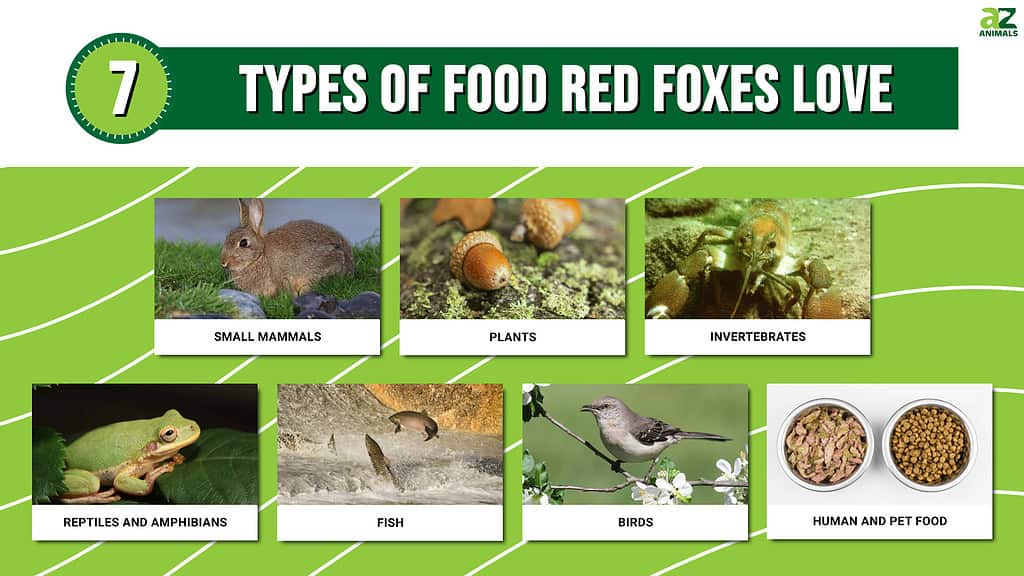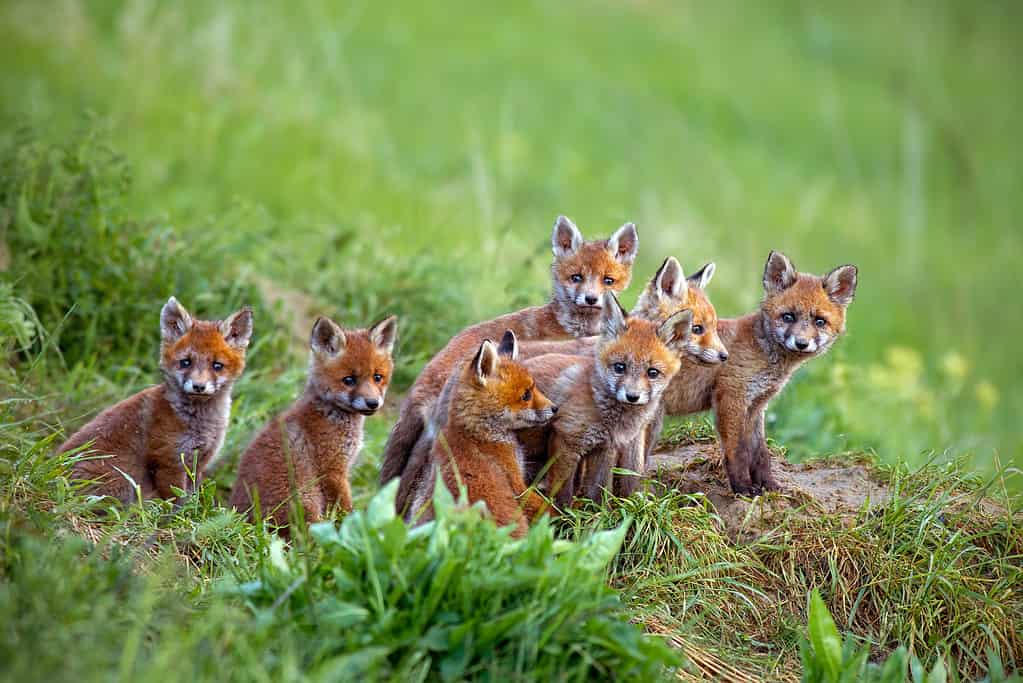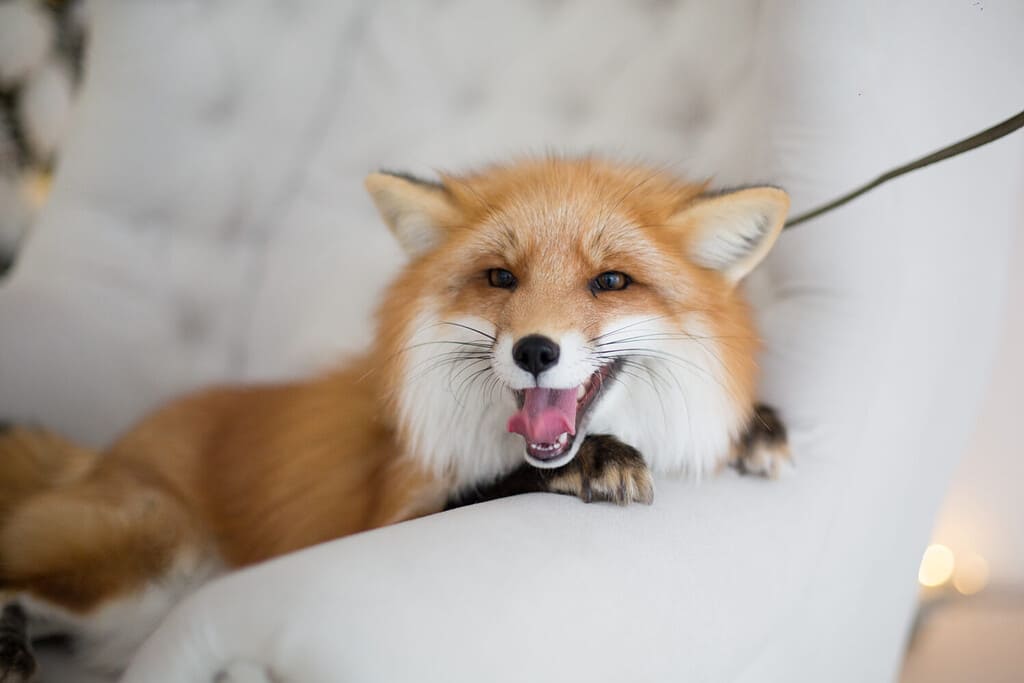From Alaska to Florida, red foxes can be found all throughout the continental United States. They are the most widely known fox from the Canidae family. Red foxes prefer woodlands, rural and suburban regions, wetland habitats, and brushy fields with open sections.

Red foxes have long snouts and red fur on their faces, backs, tails, and flanks. There is a grayish-white hue on their neck, chin, and belly. The ears of red foxes are enormous and pointed, and they have black-tipped paws. They are three feet long and stand around two feet tall. With these foxes being so common, you might wonder just what red foxes eat. Let’s dive into the diets of these omnivores!
What Do Red Foxes Eat?
Red foxes eat a wide variety of plants and animals including rodents, rabbits, small mammals, birds, insects, lizards, frogs, fish, and berries. Foxes can adapt their diet to their environment and the season.
Red foxes are extremely clever, omnivorous creatures that eat a wide range of foods, including:

Small Mammals
Red foxes prefer small mammals that look like mice, such as gerbils, voles, rabbits, opossums, raccoons, and squirrels, which are the main diet of red foxes. Even rotting carcass flesh or carrion might be a treat for them.
Plants
Red foxes eat a lot of plants including grasses, acorns, tubers, grains, and even fungi. Although Red foxes enjoy vegetation, in the autumn, they prefer to eat fruits. Cherry, persimmon, mulberry (blueberry), grape, plum, apple, and raspberry are some of their favorites.
Invertebrate
Red foxes eat a variety of invertebrates, including insects like crickets, grasshoppers, and beetles. They also consume mollusks and crayfish in large quantities in the right environment.
Reptiles and Amphibians
Red foxes are known to eat small reptiles and amphibians such as frogs, toads, lizards, and snakes. If they can catch it, the fox will most likely eat it!

Red fox pups are as energetic as they are adorable.
©JMrocek/ via Getty Images
Fish
The red fox is a master hunter. They can catch fish and small crabs for a nice treat if they are near the correct water supply.
Birds
Red foxes will also eat small birds, such as baby birds or eggs. They have a particular fondness for songbirds and waterfowl.
The “Kitchen Sink”
Red Foxes are always on the lookout for their next food source. They will even scavenge food from garbage cans or farms. Their ability to find food even in the dead of winter explains why red foxes have earned the reputation of shrewd and intelligent predators.
What Are a Fox’s Favorite Foods?
Neighborhood red foxes are known to eat prepared or raw meat and even canned dog food. Additionally, they enjoy peanuts as well as various fruits, cheeses, and even wild apples.
What Do Baby Foxes Eat?

Baby red foxes consume smaller prey like mice.
©iStock.com/slowmotiongli
When red fox pups initially emerge from their dens, they are more likely to attack brown mice because these are the first creatures they typically see and are easy prey. In addition, at very young ages, parents will regurgitate food for their pups. Baby foxes will start consuming solid foods at about one month of age.
What Do Pet Red Foxes Eat?
If you’re considering keeping red foxes as pets, you’ll need to be aware of all the food these animals require. Fish, eggs, boneless poultry, jams, wet or dry dog food, and peanut butter sandwiches are all on the list of domestic treats they seem to like.
Do Red Foxes Eat Cats?
Make no mistake, red foxes will go after cats if they see one. Kittens and cats under five pounds are particularly vulnerable to foxes and are no match when it comes to an attack. They’re wild animals that are prone to hunting, however, if they’re threatened by a cat’s claws and teeth, foxes tend to flee. This isn’t a regular occurrence.
Do Red Foxes Eat Porcupines?
Hedgehogs are occasionally preyed upon by red foxes, which are a smaller version of the porcupine. In fox droppings, hedgehog remains are abundant, however, it is not clear if these hedgehogs were predated or scavenged by the red fox. To get rid of the spines, foxes tend to gnaw on them.
How Do Red Foxes Hunt For Food?

Red foxes have excellent hearing—they can hear rodents digging miles underground.
©iStock.com/William Chua
Red foxes hunt for food alone and at night. Unlike other large predators, red foxes thrive in suburban and rural areas. Red foxes can reside in parks and woodland edges and are solitary hunters, making it easy for them to hide.
Red foxes can also hear extremely well. They can detect low-frequency sounds and hear rodents burrowing in the ground. A combination of pouncing and digging is used to find animals moving underground or under the snow in winter.
To catch prey, the red fox digs in the soil or snow. Like a cat, the fox approaches slowly then pounces and chases if the prey escapes! Even when it’s full, the red fox will keep hunting. It keeps additional food hidden in fallen leaves, snow, or mud as a kind of storage.
Bonus: Do Red Foxes Make Good Pets?

Foxes can make good pets with a lot of special training.
©Sergey Bezgodov/Shutterstock.com
You’ve probably seen foxes as pets on the internet – and they certainly are appealing! But, is it a good idea to keep a fox as a pet? In rare cases, it can work out just fine – unfortunately, most of the time foxes are just too much to handle.
Unlike dogs, cats, and cows, foxes have never been domesticated – a process that takes generations to achieve. They retain their wild animal instincts and don’t do as well as indoor animals. While foxes have adapted to living near humans and may not be aggressive towards them – they still need access to prey and plenty of space to run off their foxy energy. Here are some traits that make being a fox parent difficult:
- They are extremely energetic. If they don’t get enough enrichment they will destroy their confined space out of boredom.
- They can’t resist marking their territory. Not only can they not resist – their marking smells terrible and it would be almost impossible to get rid of the smell.
- Foxes are really, really, loud. They scream to the top of their lungs during mating season and whenever they feel threatened – and it sounds like a human in distress.
- Housetraining is extremely difficult and rarely achieved.
- They can’t be trained to walk on a leash unless they are young cubs.
- Foxes need a lot of space. Research suggests at least 25 square yards are needed for a fox to thrive in captivity.
- They may attack other pets.
If you aren’t deterred by all of the cons of owning a fox – know that their diets are quite similar to dogs. High-quality dog food supplemented by deer meat or whole fish several times a week will keep them satisfied and healthy.

Being a fox parent is not easy – but it can be rewarding for the right person.
©Mary_wolf88/Shutterstock.com
Summary of 7 Types of Foods That Red Foxes Love
Red foxes are omnivores – so they eat almost anything they can catch or find.
| Rank | Food | Types |
|---|---|---|
| 1 | Small Mammals | mice, voles, rabbits, opossums, raccoons, squirrels |
| 2 | Plants | grasses, acorns, tubers, grains, fungi, fruits |
| 3 | Invertebrates | crickets, grasshoppers, beetles, mollusks, crayfish |
| 4 | Reptiles and Amphibians | frogs, toads, lizards, snakes |
| 5 | Fish | any kind they can catch |
| 6 | Birds | small birds, eggs, songbirds, waterfowl |
| 7 | Human and Pet Food | pet food and garbage |
The photo featured at the top of this post is © Michal Dobes com/Shutterstock.com
Thank you for reading! Have some feedback for us? Contact the AZ Animals editorial team.






